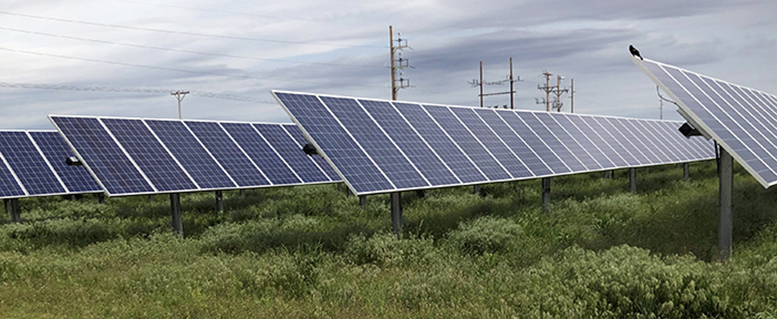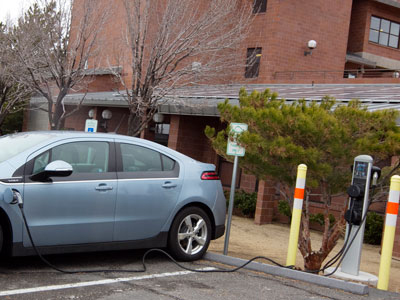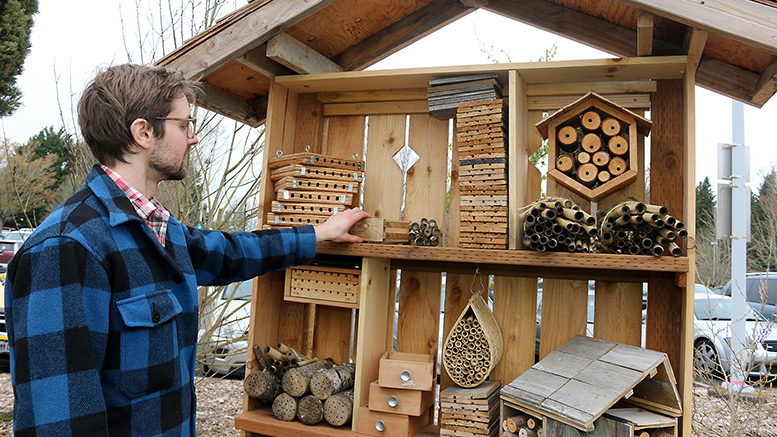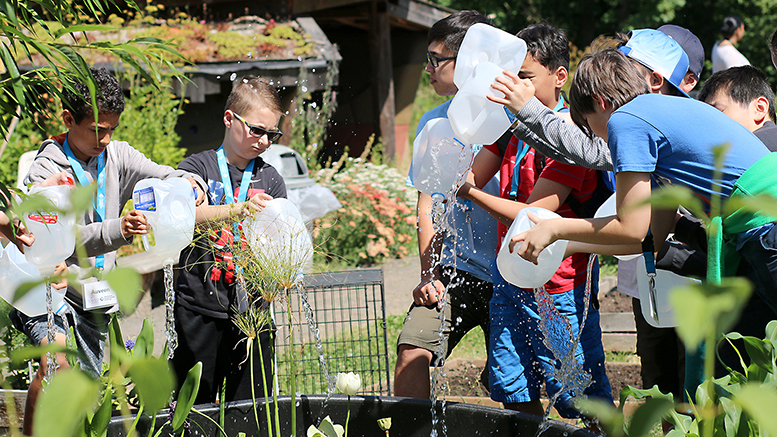Reducing the impact of climate change requires leadership from higher education, and many community college presidents are taking up that commitment by educating students about sustainability.
Public two-year colleges are addressing climate change in other ways, as well. They are training a green workforce, working with local governments on climate action plans, reducing their use of fossil fuels and influencing state energy policy, says Debra Rowe, a sustainability expert and professor at Oakland Community College in Michigan.
More than 750 college and university presidents have signed Second Nature’s climate commitment, calling for them to work toward carbon neutrality and take on a leadership role in building climate resiliency.
A degree in climate change
Rowe encourages colleges to “get students engaged in solutions.” If colleges only focus on the coming potential disaster wrought by climate change, “students feel overwhelmed and nervous about the future.”
That’s the motivation of West Los Angeles College (WLAC) in California, which this spring launched the only program in the nation that grants an associate degree in climate change.
“I’ve been concerned about climate change for the last couple of decades,” says WLAC President James Limbaugh. “I realized I have a moral responsibility to help students from urban areas like Los Angeles to be aware of climate issues.”
“Students need to understand that climate change is the biggest single problem we are facing globally,” Limbaugh continues. The effect is felt in Los Angeles, as “we’re seeing more fires and mudslides and large shifts in temperature.”
The college’s climate change and environmental studies degree is interdisciplinary and covers the science behind climate change – such as changes in temperature and ocean circulation – along with the effect on economics and society, says Jennifer Cole, assistant professor of earth science. In addition to core courses in global climate change, environmental ethics and statistics, students can select among a variety of electives, such as chemistry, biology, geology, economics of globalization, cultural elements of geography and American social problems.
Students who transfer and earn a bachelor’s degree can pursue a career as a climate change program manager, climate resilience specialist or sustainability consultant, Cole says. There are other broader career options as well, such as water quality specialist, green buildings manager and science educator.
Along with the degree, WLAC works with the Audubon Society’s Los Angeles chapter to help students with conservation projects at the Baldwin Hills Conservancy, which is on a reclaimed oil field next to the college.
A focus on sustainability
Central Community College (CCC) in Nebraska is addressing climate change on several fronts through its environmental sustainability action plan. Since CCC carried out a baseline energy study in 2013, it has reduced greenhouse gas emissions by nearly half, says sustainability director Benjamin Newton.
Students who show their knowledge and skills in sustainability in any academic discipline can earn an e-badge in one of three areas: environmental stewardship; symbiosis, which relates to pollinators and pollinator habitats; and problem-solving. Currently, 127 students are working on an e-badge, which is displayed as a logo on a student’s transcript.

A solar farm at Nebraska’s Central Community College. (Photo: CCC)
Students running sustainability projects using the scientific method can be selected to give a presentation in the sustainability tent at the Nebraska State Fair. This year, 12 students are working on this. Previous projects included mini-wind turbines, crayfish hydroponics, native plants, house walls made of hay bales or recycled aluminum cans, and a display room with furniture made from cardboard.
CCC offers certifications and an associate degree in energy technology, which covers energy efficiency, an introduction to sustainability, and wind and solar energy, which Newton says is booming in central Nebraska. A component on battery storage will start this fall.
The college has taken steps to reduce its own energy use, including small wind turbines on two campuses and a small solar array. Hybrid vehicles comprise 35 percent of its fleet.
The Hastings campus is carbon neutral, Newton says, and CCC’s new Kearney Center is certified as sustainable by LEED (Leadership in Energy and Environmental Design). The building is powered by the public utility’s solar farm and has windows that shade themselves during the day, among other energy-saving features.
Other sustainability projects at CCC include composting food waste for campus gardens, free bike rentals, plastic bag recycling, pollinator gardens and a greenhouse that offers free produce to students.
CCC hosts monthly webinars on sustainability topics for other institutions of higher education and nonprofits in Nebraska, and Newton chairs a “resiliency committee” that includes city officials, nonprofits and students.
Newton acknowledges the conservative mindset in Nebraska could be an obstacle, so it’s best to focus on how sustainability benefits the community and the economy. “If I talk about environmental stewardship rather than climate change, I get a lot farther,” he says.
The future of transportation
Truckee Meadows Community College in Nevada is addressing climate change through several channels, including a robust advanced manufacturing program focusing on electric vehicles, says President Karin Hilgersom.
TMCC is training thousands of workers for jobs at a huge Tesla factory and a Panasonic plant that produces batteries for Tesla, Hilgersom says.

An electric vehicle charging station and solar panels at Truckee Meadows Community College. (Photo: TMCC)
The college uses robots like the ones used by Tesla to train students to troubleshoot the assembly lines and use computer programming to make adjustments, she says. Some 922 students are working as apprentices at local companies, including nearly 400 at Panasonic.
“I am passionate about sustainability,” Hilgersom. says. “It’s wonderful to be part of the vision of having transportation systems that don’t rely on nonrenewable energy.”
To ensure a greener campus, Hilgersom created two new positions: One administrator leads sustainability efforts in student operations, and another works with faculty to infuse sustainability and climate issues into all types of courses – humanities and business, for example, rather than just science or environmental studies.
The goal is to have “a campus culture that understands sustainability,” she says. “If you get faculty on board, it’s easier to get students involved.”
The two sustainability leaders, along with faculty, facilities staff and student government representatives, serve on a Sustainability Champions Committee, that sets an agenda and spearheads initiatives, such as a tour of a recycling plant.
A faculty group called FREE (Faculty for Radical Empowerment and Enlightenment) chooses a theme to work on all year with students. This year, the topic was food and sustainability, and students and faculty presented poster sessions on those issues.
Doing what they say
To discourage students from using plastic water bottles, TMCC installed 17 hydration stations for refilling reusable water bottles quickly.
The campus also has four solar arrays, electric vehicle charging stations and a couple of small wind turbines. There’s a garden on campus aimed at educating the college community about the effect of climate change on the watershed and “food shed.” And students can learn about environmental issues by interning at the Desert Research Institute co-located at TMCC.
This summer, the TMCC board will consider a proposal to join the NV Energy Rider, a program of the state’s largest utility that calls for large customers to pay a little more to receive energy from renewable sources.
“All of this links to the issue of carbon in our environment, the need to build a culture around sustainability and to understand how these systems work together,” Hilgersom says.
The social justice aspect
At Portland Community College in Oregon, where sustainability is part of the college’s mission statement, PCC “is helping to grow the next generation of climate leaders,” says President Mark Mitsui. “We are not shy about confirming that climate change is happening and is man-made.”
The college has more than 100 courses on sustainability or climate issues, Mitsui says, including biology courses specifically focused on global warming and high-impact strategies to reduce greenhouse gas emissions.
PCC is on track to meet its goal of achieving a 40 percent reduction in the use of fossil fuels in campus operations and vehicles by 2030.

Portland Community College art instructor Will Moss collaborated with the Rock Creek campus’ sustainability program to construct a bee hotel to help ensure a healthy population of pollinators. (Photo: PCC)
That is happening through the college’s three photovoltaic solar arrays, nine sustainable buildings certified by LEED, a shuttle system to reduce single-vehicle trips, a bike-share program and a new Climate Action Fund to support special projects aimed at reducing greenhouse gas emissions.
Five on-campus learning gardens serve as closed-loop systems to promote sustainability by using compost from cafeterias to grow food for students. A farm stand at PCC, the Portlandia Farmstandia, sells produce from the gardens.
PCC is the founding institution of the Washington and Oregon Higher Education Sustainability Action Conference, a founding member of the Greater Portland Sustainability Education Network, a member of Portland General Electric’s Clean Wind Program and a founding member of the Sustainable Purchasing Leadership Council.
“Purchasing is really important,” Mitsui says, noting that PCC integrates sustainability in the competitive bidding process and emphasizes using reusable and recyclable products.
The PCC board of directors also approved a divestment policy that calls for the college to sell shares in oil companies and similar investments that are not compatible with sustainability.
As a result of his activism on climate issues, Mitsui was invited to the United Nations Climate Conference in Bonn, Germany, a couple of years ago. Although the United States had pulled out of the Paris Climate Agreement, the U.S. had a privately funded presence at the conference through the We Are Still In It coalition of state and local governments, businesses, nonprofits and educational institutions.
Student-led efforts
The focus on sustainability saves the college money on energy, and could even help with enrollment, Mitsui says, as students across the country increasingly want to attend colleges that share their values on sustainability.
Students at PCC have taken a leadership role in addressing climate change. The student government provided more than $1 million from student fees for Eco Social Justice grants for sustainability projects.
“Students are bringing passion to this,” Mitsui says. “They are very aware of the condition of the planet; the disparate impacts of climate change on poor communities, people of color and poor island nations and the environmental justice aspect of climate change.”
“We need to be doubling down right now,” he says. “Higher education is part of the coalition of actors that are taking the lead now. It’s an important time for us to step forward.”

